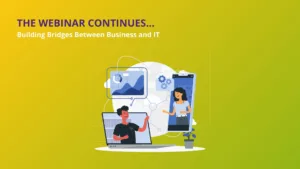The Business-IT Divide, a problem faced by many professionals. On March 7th BPM Power organized a webinar together with WEBCON. During this webinar we discussed the business-IT divide. Since the webinar is in Dutch, we will share some blogposts in the next weeks. Do you speak Dutch and want to watch this fun bunch discuss the topic? You can register and immediately watch the replay of the webinar here.

“Business and IT goals are in conflict with each other”
Business and IT are in conflict, not necessarily in terms of actual fights happening in the office, but their goals cause conflict, explains Arno van der Heijden in the webinar. Before we dive into what these goals are, let’s define these two groups: who is business and who is IT?

The Business Team
When we talk about business, we simply talk about every aspect of a business that is not IT. Whether it be HR, Sales, Customer Service, or literally any other department you can think of. It’s the people whose purpose within the organization is not to implement, maintain, develop or sustain any technological aspects. Their customer is the business’ customer, making sure everything is running smoothly in order to satisfy the customer’s needs.

The IT Team
A bit of a stereotypical picture. Men behind computer screen with a bunch of text on them. When discussing IT this is typically the situation we refer to. Although nowadays IT teams do not consist solely of developers. Within IT we find system administration, maintenance, networking, database management, security operations, et cetera. The only differentiator between these two groups is that any IT professional has some responsibility for an aspect of the information technology within the organization.
Root Causes of the Divide
We briefly touched on it, business and IT have different objectives. One might think this is not necessarily a problem. By all means, HR has different objectives than sales does, but these do not interfere with one another. In the case of business versus IT, we see something else. These objectives are actively conflicting with one another.
On the one hand we have the business. The business side of an organization needs to be flexibel. With the constant effects of external factors influencing daily business, flexibility is not desirable, it is required. Delivering products or services on time, in accordance with contracts, whilst managing any negative or positive influences is not an easy task. When applying this to IT related projects, this might mean that when a system is outdated, or non existent, business professionals might ask IT to get it fixed/implemented as soon as possible. There is no time to wait.
IT professionals on the other hand have a responsibility for security, functionality and innovation. Every piece of information on any employees’ computer is business information, which might be confidential in some way, or perhaps might include personal information. Allowing just any piece of hardware of software in an organization is impossible to manage for any IT team. Then there is the challenge of keeping these products and systems running, which in some cases might be a thousand-fold of laptops, printers, networks and not even to mention applications. We have seen scenarios where businesses run over 400 applications in different systems: would you like to manage those?

Communication Barriers
A big difficulty in the gap between business and IT is caused by communication, or a lack thereof. Business and IT people are often very different at their core. This means their way of thinking and the approach they take at their work is different.
However, this is not the only thing that makes communication difficult. The jargon and technical language used by IT members can often be perplexing to business professionals. This leads to misinterpretations, which can cause unmet expectations. The lack of a common language between these two groups is a giant barrier to effective collaboration and mutual understanding.

Organizational Culture
Organizational culture significantly influences whether business and IT work together seamlessly, or operate in silos. The values, beliefs, and practices that shape how company employees interact, make decisions, and solve problems is perhaps the biggest influence.
In many organizations, a culture that promotes silos is a main culprit behind the gap. When business and IT are encouraged to prioritize their own goals and objectives over those of the organization as a whole, it fosters an environment where collaboration is the exception, not the norm.
Working in silos often leads to unsuccessful implementations of new applications. When IT and business do not work together on implementations, it results in solutions that only partially meet business requirements.
Real-World Impact on Organizations
The impact of the divide between business and IT can have tangible effects on your organization’s ability to innovate, respond to market changes, and execute strategies efficiently. In our webinar, we discussed the example of the acquisition of a CRM system. The system was supposed to be the perfect solution to the business’ needs. However, fell short due to a lack of comprehensive understanding and collaboration between business and IT. This shows how crucial alignment between different departments is for the success of such initiatives.
Conclusion
In the webinar “De Kunst van Samenwerken: Bruggen Bouwen tussen Business en IT” we offered valuable insights into the challenges and opportunities found in the midst of the business and IT landscape. By understanding the root causes of the business-IT divide, such as differing priorities, communication barriers, and organizational culture, companies can take meaningful steps towards fostering a more collaborative, efficient, and innovative environment.
Stay tuned for the next installment in this series, where we’ll explore the crucial role of software in bridging the gap between business and IT, again leveraging insights from our webinar.



